Eric C. Sheninger's Blog, page 19
September 5, 2021
Trust is a Leader's Best Friend
When I began the journey to become a school administrator many years ago, I took the typical courses that were required. These focused on topics such as school law, instructional leadership, change management, school finance, and curriculum development, among many others. While I felt adequately prepared when I finally became a building leader, I quickly realized how valuable the on-the-job training was to my growth. Truth be told, no book or course can replace authentic experience.
Leadership is hard. Initiating and sustaining change is even harder. Below are some thoughts I shared a few years back:
It is difficult to adequately prepare any leader for the challenges they will face as well as the decisions that will have to be made. There are so many unique variables that just cannot be taught. It’s tough work knowing that difficult decisions will have to be made at times, including letting staff go. Making decisions in a time of crisis is also a topic that is regularly explored in leadership courses. The solutions addressed always sound great in theory, but their application typically isn’t very practical. Talking the talk must be accompanied by walking the walk. That’s the hard part. It’s relatively easy for people to tell others what they should do. However, true leaders go through the challenging work of showing how it can be done. Accomplishments and success are earned through the actions that are taken that result in evidence of improvement. Leaders know that it is not the work of one person that moves an organization in a positive direction but rather the collective efforts of all.
Knowing the inherent difficulties in leading, it is critical to developing an understanding of what can stymie or ensure success. Relationships are of utmost importance, but these do not materialize out of thin air. Trust is a leader’s best friend. Recently my publishers Jeff Zoul and Jimmy Casas, shared their views on the topic. I encourage you to give the piece a read, as it contains some valuable insight. As I work as a leadership coach in schools, the topic of trust comes up all the time. The following seven elements are critical in building and sustaining trust: empathy, delegation, consensus, transparency, autonomy, feedback, and communication.
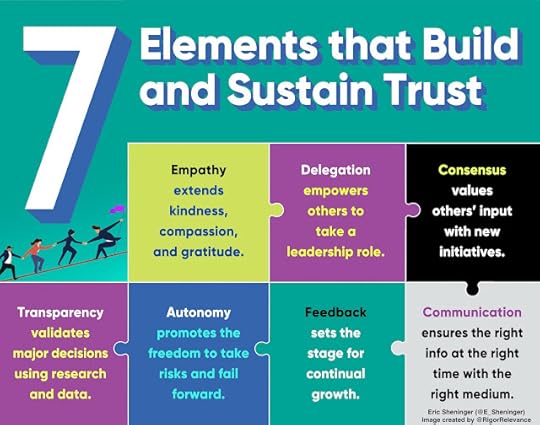
Empathy through kindness, compassion, and gratitude is fundamental to creating powerful relationships. Whether it is a simple thank you, consoling a staff member, or handwritten notes of appreciation, using a consistent empathetic lens pays dividends ten times over.
Delegation builds capacity by empowering others to take a leadership role. If a leader tries to do everything by themselves, the result can lead to mistrust. Look for opportunities to develop the leadership potential in your staff.
Consensus values the input of others when implementing large-scale initiatives. When warranted, use a committee approach or create a district or school-based leadership team that contains a wide range of staff to garner input.
Transparency validates major decisions using research and data. When there is clarity as to why decisions are made, the seeds of trust begin to take root. Transparency also infers personal accountability by a leader if things don’t work out, as a unilateral decision is made when needed.
Autonomy creates a culture that promotes the freedom to take risks and fail forward. In Disruptive Thinking, I highlighted how autonomy helps educators move beyond their fears, which leads to a pursuit of innovative practices. Additionally, influential leaders know when to get out of the way of their staff and let them flourish.
Feedback that is timely, specific, consistent, actionable, and focuses on a dialogue sets the stage for growth. Trust develops when leaders are always looking for ways to help their staff improve or avoid pitfalls.
Communication, when done effectively, relies on getting the right information out at the right time using the right medium. While disseminating information consistently and with clarity is critical, non-verbal means such as listening and body language are just as, if not more, necessary. As I shared in Digital Leadership, you won’t find an effective leader who is not an effective communicator.
All of the elements above help a leader build trust amongst staff resulting in a positive school culture. While there is no single silver bullet, consider where there is an opportunity for growth and the actions that need to be taken to either build or strengthen relationships through trust.
August 29, 2021
The 6 Dimensions of Disruptive Thinkers
What is really needed for success in the world today? I think this might be the million-dollar question. Even though it is difficult, if not impossible, to predict the future, we can examine current trends and societal forces to determine the competencies that learners need to thrive. While some will remain the same, others will evolve or change completely depending on the disruption at the moment. What I think we can all agree on is that in the face of disruptive forces, conditions in classrooms need to empower learners to replace conventional ideas with innovative solutions to authentic problems. This is how I define disruptive thinking.
On the front lines of this endeavor are educators tasked with balancing mandated curriculum and testing with the responsibility to prepare students for college and careers. The former can result in perceived roadblocks to accomplishing the latter. Success relies on instructional strategies and pedagogical techniques that both engage and empower students to dive deep into standards and concepts while applying them in meaningful ways. While there is a time and place for content to be disseminated through instruction, the key to accomplishing all that educators are tasked with is how the learning experience develops a student’s ability to think and do in relation to the current and future workforce.
In Disruptive Thinking in Our Classrooms, I identified six dimensions of disruptive thinking. Now I didn’t refer to them as these in the book, but the purpose of my blogging is to share my reflections and expand on ideas. Maybe dimensions aren’t the proper term, but to create a culture of disruptive thinking in a classroom or school, learning should result in students developing into:
Creative scholars generate and explore ideas and make original connections. They try different ways to tackle a problem, working with others to find imaginative solutions and outcomes that are of value.
Reflective learners evaluate their strengths and limitations, setting realistic goals with criteria for success. They monitor their performance and progress, inviting feedback from others and making changes to further their learning.
Collaborative workers engage confidently with others, adapting to different contexts and taking responsibility for their own role on the team. They listen to and take into account different perspectives. They form collaborative relationships, resolving issues to reach agreed-upon outcomes.
Active engagers readily explore issues that affect them and those around them. They actively engage in the life of their school, college, workplace, or wider community by taking responsible action to improve others as well as themselves.
Self-directed managers organize themselves, showing personal responsibility, initiative, creativity, and enterprise with a commitment to learning and self-improvement. They actively embrace change, respond positively to new priorities, cope with challenges and look for growth opportunities.
Autonomous inquirers process and evaluate information in their investigations, planning what to do and how to go about it. They make informed and well-reasoned decisions while recognizing that others may have different beliefs and attitudes.
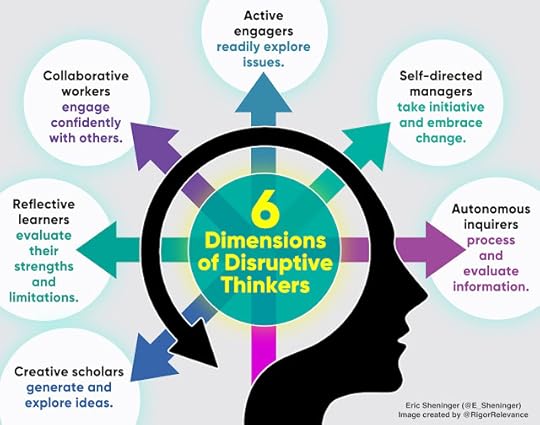
Preparation just for promotion, graduation, or an exam doesn’t serve the best interests of kids. Each of the dimensions above allows for students to explore the curriculum in relevant and authentic ways while more than adequately preparing them for any standardized test they are forced to take. Each plays a critical component in fostering a disruptive thinking mindset. More importantly, they empower learners to develop essential competencies that will serve them well no matter the chosen path in life.
Incorporating these are not as difficult as you think as they naturally result when sound pedagogical strategies are employed, such as cooperative, personalized, problem-based, blended, and project-based learning, just to name a few. Many can also be developed or amplified through extracurricular programs, virtual courses, independent study, and work-study options. Disruptive thinkers are what the world will always need. Let’s make sure they are readily available.
August 22, 2021
No Act of Kindness is a Wasted Effort
I fly a lot. Even during the heart of the pandemic, I was on the road coaching in numerous school districts as part of long-term projects. Now things are absolutely crazy but in a good way. Job-embedded and ongoing professional learning is being prioritized in schools, which means my travel is back to pre-pandemic levels. As much as I love what I do, being away from the comforts of home is stressful. Any little perk I can get is well received as it makes it a tad bit easier to be away from home. Herein lies the reason why I am loyal to one airline.
From my lens, loyalty has its benefits. Thus, I tend to fly United no matter what. The only time a different airline is selected is because I have no other choice if I want to get to that location without having to drive a long distance once I land. On a recent Sunday, I headed from Houston, TX to Omaha, NE to kick off the year for Papillion La Vista Community Schools. Usually, I head out earlier in the day, but on this occasion, I opted to take a late flight out so I could spend time with my family. Once on the plane, I did what I usually do – sleep. Work also manages to get done at some point, but for some reason, I am out cold taxiing to the runway.
I must have been extremely exhausted as I slept the entire flight. As the plane landed, I quickly drank some water and gathered my belongings. A flight attendant named David handed me a postcard with a handwritten note and thanked me for my loyalty on the way out. I can’t begin to express how much this meant to me. The life of a road warrior isn’t for the faint of heart. It can actually get quite depressing at times as well as tiring. David’s random act of kindness did not go unnoticed. In fact, it has been on my mind each time I board a United plane. Below is a picture of the note.
Technology sometimes removes the human element from kind gestures. The note David wrote would not have had the same impact or value if it had been in the form of an email or text. Now I am not saying these gestures aren’t effective, but if you can go with a more traditional option the act of kindness can be amplified. In our busy lives, we often overlook the little things. David took a few minutes out of his day to be kind, and it mattered.
Never miss an opportunity to show gratitude or bestow kindness on another person. Small, selfless acts like these don’t take much effort but can totally change the trajectory of other people and maybe even yours.
Whether you are a teacher or an administrator, the little time it takes to bestow kindness on a student, colleague, or parent could be the best few minutes of their day and possibly yours. Even though texting and email are the convenient approaches, consider these options:
Handwritten note or Post ItCard with a personal messageFood, especially sweetsA small, inexpensive gift that has meaningPhone or video callDrop by a classroom, office, home, or anywhere else physicallyCover a class for a teacher or colleague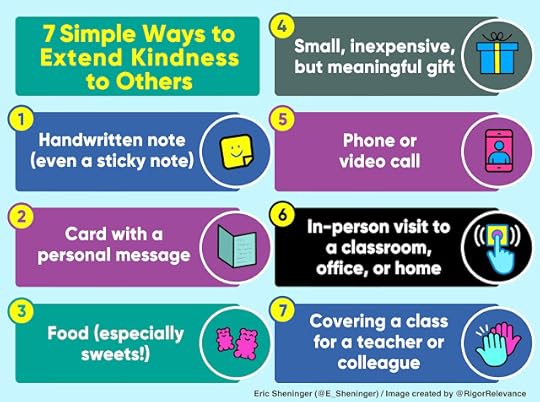
No act of kindness is a wasted effort. With the pandemic still negatively impacting the lives of so many, going the extra mile to be nice and show gratitude is worth its weight in gold. While the business of life often gets in the way, making consistent efforts to show kindness is what the world can always use a little bit more of, especially right now.
August 15, 2021
Disruptive Thinking: Making it a Reality
It has been a wild and bumpy ride during the pandemic, but through it all, we have witnessed firsthand the resilience of educators across the world. While COVID-19 represented the most disruptive force ever to impact the field of education, educators did what they always do – go above and beyond for kids and each other. They have and continue to make lemonade out of a never-ending supply of lemons. Challenges were once viewed as obstacles. Now they are seen as opportunities to innovate.
A golden age of transformation is upon us and the time to act is now. By leveraging the lessons learned during the pandemic as well as from recent disruptors such as Amazon, Netflix, Uber, DoorDash, and Airbnb, educators can plan and work to future-proof learning for all kids. To do so, the right mindset and strategies are needed to create classroom cultures where learners are empowered to replace conventional ideas with innovative solutions to authentic solutions. This is the essence of preparation for now and the unknown, something that is woven throughout Disruptive Thinking in Our Classrooms. As I have said for years and emphasized in the book, “Don’t prepare learners for something. Prepare them for anything!”
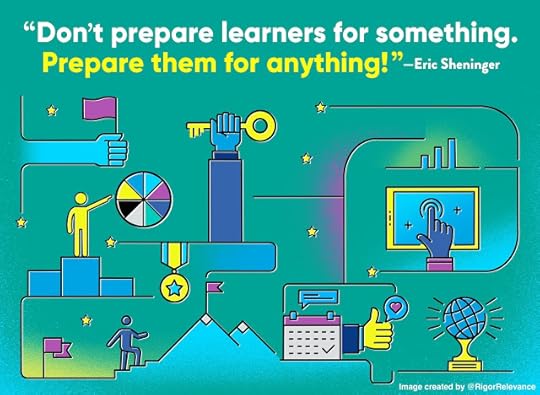
When it comes to change, there is always a dominant focus on the why. At this point, I think every teacher and administrator has some context, especially in light of the pandemic, as to the need to rethink practice. Many people get hung up on how to effectively implement innovative strategies that lead to new and improved results aligned to research and based on actual evidence. Herein lies the driving force that compelled me to write the book.
Below are some of the ways the book can help you make disruptive thinking a reality in your classroom, school, district, or organization.
Summary
Broken into four parts, this book combines stories, insight from thousands of school visits, practical strategies, research, lessons from the pandemic, and examples from classrooms to assist educators in transforming their practice. The parts are:
Rethinking “normal”Rethinking learningRethinking the learnerRethinking our mindsetEach chapter ends with a “disruptive challenge” designed to do just that: challenge educators to disrupt in some way their current thinking or professional practices.
Supplemental resources
Over time things change. Knowing this compelled me to reflect on how to create a relevant resource that would evolve over time. I have been blogging since the book was published to align updated content, ideas, and strategies to each chapter to deliver on this goal. I have also developed new graphics to support educators as they work to help their learners become disruptive thinkers. To this end, a Pinterest board materialized that is updated regularly. As I learn and reflect through my work in schools, my goal is to keep this link fresh with innovative content.
Study guide
I can’t speak highly enough about ConnectEDD as they have been a true partner as a publisher. Not only do they support their authors, but they are building a vibrant community. To that end, a comprehensive study guide can be found on their site. If you are looking to grow individually or collectively as part of a book study, be sure to have this resource on hand. Impressive bulk discounts are also available. For more information, email info@connecteddpublishing.com.
Hashtag
Trying to develop a short, catchy hashtag (#) that no one else is using extensively is a challenge these days. In the end, we came up with #DisruptiveThink. The overall purpose is for educators to share their questions, reflections, and innovative practices they have implemented on Twitter, Instagram, Facebook, and LinkedIn. It also represents a convenient way for me to interact with readers at any time, even if my social media handle isn’t included.
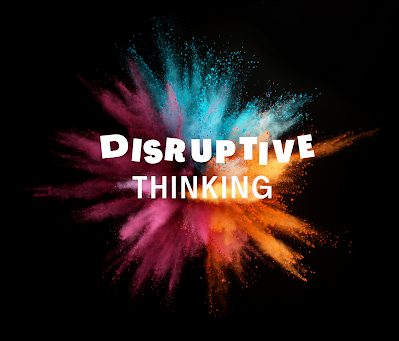
Disruption represents a continuous call to action as forces that radically change society will always be in play. We have the ultimate antidote: employing a mindset and strategies that equip learners with needed competencies and the ability always to be prepared. The solution is disruptive thinking.
August 8, 2021
RTI and Personalization: A Dynamic Duo
Recently I was working with the leadership team at Moanalua Middle School (MMS) in Hawaii. One of the coaching topics that came up was how to improve the Response to Intervention (RTI) process as a means to support learners. It represents a multi-tiered process to identify the behavior and learning needs of struggling students early on and then provide specific support in the form of interventions. Below is a quick summary of the RTI components:
Tier 1 – Teacher provides research-based instruction to the entire class using extensive checks for understanding as a means of formative assessment. This data and that collected through routine benchmarking are utilized to determine what supports are needed in Tier 2. Behavior screenings are implemented as well.Tier 2 – Targeted supports using the data collected from the Tier 1 interventions are used to provide small group instruction that focuses on specific learning and behavioral needs. Tier 3 – At this level, the most at-risk students are provided individualized support, typically in a one-on-one setting.In the past, Chris Weber provided a series of guest posts on the topic that I encourage you to take a look at as each contains a host of ideas and resources. I can’t overstate the wealth of information Chris shared. He is my go-to thought leader on anything related to RTI and emphasizes the need for scaffolding, differentiation, and collaboration throughout the process.
As we dove into the different tiers of support at MMS, I quickly made a connection to the essential elements and strategies inherent in personalization. In Disruptive Thinking in Our Classrooms I emphasized that the driving premise of personalized learning is a focus on student needs and interests to develop a greater sense of ownership of learning. Core elements include making instruction, pedagogy, and curriculum personal for students, which aids in alleviating many behavioral issues that arise. The use of data is also prevalent as a means to address individual weaknesses as well as build upon strengths. Successful personalization hinges on the use of high-agency strategies such as voice, choice, path, pace, and place throughout a lesson or unit of study.
Below I have taken the traditional RTI pyramid of supports and added how personalized learning strategies could be implemented to ensure better learners are getting what they need.

Tier 1 (Large group instruction with voice and choice)
While emphasizing the critical elements outlined at the beginning of this post, the teacher makes learning more personal through student voice. Digital tools or individual whiteboards are used so that each child can respond to various checks for understanding, which can also screen students to begin to determine Tier 2 supports. Choice is provided by allowing students different ways to respond to questions to amplify strengths. Benchmark assessments are provided at routine intervals to collect data for further screening. This can be done with or without technology.
Tier 2 (Targeted instruction, differentiation, and pacing via station rotation)
Data collected during Tier 1 is used to group students accordingly so the teacher can maximize available time to address both learning gaps and behavior issues in a station rotation model. While the tasks in the other rotations can vary, in an RTI model, an adaptive learning tool should be used in one of them to address weaknesses while allowing other students to move ahead at their own pace and path. If there is in-class support, a targeted support rotation could be established to either provide greater assistance or screening.
Tier 3 (1:1 intensive support while rest of students work on differentiated choice activities or playlists)
The use of choice boards, must-do/may-do activities, and playlists free up valuable time for the teacher to work with individual students. Data collected and the subsequent screening during Tiers 1 and 2 help identify the learners who need the most support. As the teacher works with one student, the rest of the class progresses through activities at their own pace along a path that is aligned to both ability and interests.
RTI has long been embraced as a strategy for students who either learn differently or have behavioral challenges that are stymying growth. By taking a more personalized approach, empowerment, and ownership of learning help to alleviate many behavioral issues. Additionally, a more pragmatic approach is taken to collect, analyze, and use data in ways to better screen and establish needed interventions. Consistent check-ins on behavioral patterns and learner progress help to ensure no student falls through the cracks while personalization enhances and amplifies interventions. Hence, RTI and personalized learning are a dynamic duo.
August 1, 2021
Sparking Inquiry in the Classroom
As a kid, I loved nature. Growing up in a rural part of New Jersey and spending summers at the beach probably played a significant role in developing this interest. My parents would buy me and my brother all sorts of field guides to help support our curiosity and genuine interest in living creatures. We would venture out on routine quests to either observe or collect specimens for further study. Each expedition was driven by both observations and questions. While we loved looking at various creatures, especially those that were hard to find, such as certain salamanders and snakes, questions kept driving us to want to learn more.
The short walk down memory lane depicted above is a reminder of one of many driving forces that compelled me to become a science teacher. It also captures vital components of the scientific method, of which inquiry is the most critical component. While making observations is the first step, it is the questions that are developed during the initial stages of the process that are the most important, in my opinion. Without these, it is challenging to establish a working hypothesis to test out.
No matter the subject taught or concepts explored, questions are more important than answers if inquiry is the goal. The reason being is that the process of developing them on behalf of the learner is typically driven by relevance. Or a teacher can use a scaffolded approach to spark deeper exploration of a topic through knowledge construction and application. No matter the chosen path, an inquiry-based approach can be used to cultivate ownership of learning through disruptive thinking. I define this as replacing conventional ideas with innovative solutions to authentic problems.
While creating tasks that empower learners to develop their own questions is the ultimate goal, teachers can use scaffolded stems to get the ball rolling. Below is a version of a resource that can be found in Chapter 4 of Disruptive Thinking in Our Classrooms.

Each level has numerous question stems that can assist teachers in developing checks for understanding, performance tasks, projects, and assessments. The overall goal is to work from the base level 4 as this is where authentic inquiry resides. In a disruptive world, preparing students for the present and future relies on fostering inquiry in the classroom. Every problem throughout history that has been solved with an innovative solution began with some sort of question that probably morphed over time as an inquiry-based approach was applied. Thus, educators can leverage this powerful catalyst to future-proof learning for all kids.
July 25, 2021
The Change Leader
Everyone seems to want change. While this, in essence, is a good thing, the reality is that many people don't want to actually go through the complex process. If this wasn't challenging enough, the individuals needed to lead it is even less. Thus, there must be a combination of willingness, planning, and action that results in improvement when any idea is put forth. There are many pathways to initiate and sustain change, but efficacy must be the goal no matter the chosen path. Change for the sake of change is rarely successful. Hence the need for clarity when time and resources are put forth to move a system in ways that produce better learning outcomes for all students.
Leadership isn't telling people what to do. That is a dictatorship that often results in frayed relationships, animosity, and the cultivation of those who constantly try to undermine any new initiative. Leadership is taking people where they need to be by empowering them to want to be part of the solution. What I mean here is that if people see and understand the value that the change will have on their professional practice, they are more prone to embrace what the leader is setting out to achieve collaboratively. Did you catch the pivotal component here? As the saying goes, there is no 'I" in team. The change leader understands that they might be the initial catalyst, but staff need to play an active role for any new idea or initiative to take hold.
To better understand the intricacies of being a change leader, I created the following graphic. Keep in mind that this image is meant to align with any specific path (transformational, instructional, pedagogical, managerial, inspirational) that you decide to take.

Vision and Purpose
Clarity begins with a well-defined vision and an over-reaching sense of purpose that helps others understand why change is needed. Consider this a roadmap of sorts where the destination is outlined in a way that people want to go on the journey. The seeds for change will only germinate if a coherent vision is established that instills a sense of purpose. Before going full steam ahead, gather key stakeholders to develop a shared vision that includes rationale, goals, expected outcomes, expectations, and means to assess the initiative's effectiveness.
Strategy
The real work and testament to outstanding leadership is moving past the visioning process by developing a strategic plan to turn vision into reality. Begin by aligning to research that will help to validate why the change is needed. I found this particularly useful as a principal when we worked to transform grading in my school. The planning process should also involve some consensus from key stakeholders as this will increase embracement of the change being pursued. The planning process should lead to the development of goals, preferred outcomes, and success measures. Efficacy can only be achieved if these are in place. A great strategy empowers people to take action.
Communication
You won't find an effective leader who is not a masterful communicator. It's about getting the right information out at the right time using the right means. Communication is vital in accomplishing tasks and getting things done, passing on important information, acquiring information, developing a shared vision, reaching decisions through consensus, building relationships, and moving people to embrace change. The use of body language, multi-faceted means of delivery, and listening intently are also essential when it comes to communication. Change leaders understand this and use each strategically.
Professional Learning
Change will only succeed if the right supports are in place. Vision, purpose, and strategy become wasted efforts if job-embedded and ongoing professional learning is not in place. Establishing this is crucial, but change leaders also learn side-by-side with their staff to illustrate a team commitment to the process. When appropriate, they also jump at the chance to lead the professional learning or bring in outside experts to help build capacity. Learning is the fuel of leadership.
Environment
While this might be intertwined with the previous elements listed, there are some points worth fleshing out. Change leaders don't aspire to reinvent the wheel outright. They are keen to ensure what's working remains in place while simultaneously identifying other aspects that need to be addressed. As change takes hold, they have fun celebrating the successes of staff and students. Nothing moves change along better than showing people how proud you are of their hard work. This will also assist in motivating others to embrace the change effort while creating an environment people want to be part of and help to contribute to its success.
People
The most precious resource a change leader has are the people who will implement the changes being championed. Without them on board and taking action, the status quo will reign supreme. Successful change initiatives rest on moving the masses, but you must begin at a foundational level. Hence, this is the reason why this group is the foundation of the pyramid image above. This can best be accomplished by building positive relationships at the individual level. Empower staff to embrace change by putting them in a position to experience the value firsthand for themselves. Provide autonomy to those who are already on board while focusing more time and effort supporting staff who are not yet willing to change.
Those who step up to the plate to lead change understand it is a process, not an event. They also realize that many different styles need to be embraced, such as transformational, managerial, instructional, inspirational, and pedagogical. No matter the path taken, success relies on clarity and commitment to the process as well as empowering the masses to work together to achieve shared goals. Are you a change leader? Where is there an opportunity to grow and improve?
July 18, 2021
Blending with the Station Rotation Model
Blended learning is something that is near and dear to my heart. For me, the journey began back in 2011 when we first introduced the flipped approach at New Milford High School, where I was principal, with resounding success. As I transitioned from the principalship to supporting districts and schools, I learned that blended learning was a powerful pedagogical strategy that could unleash students' potential while meeting their diverse needs. Over the course of many years, my work with Wells Elementary School provided a foundation that I pull from to this very day. It's one thing to talk about blended learning, but another to actually illustrate the many ways it can be implemented effectively and at scale. Wells did the latter exceptionally well.
Technology is a significant component, but not every activity has to incorporate some type of tool. The key is to find strategic ways to use it as a means to improve learning, something that is emphasized in Disruptive Thinking in Our Classrooms. There are many ways to blend, but it is vital to have a firm understanding of the underlying premise of this strategy. Hence, the definition I created a few years back:
Blended instruction is what the teacher does with technology. Blended learning is where students use tech to have control over path, place, and pace.
In the past, I have penned detailed posts on choice boards, playlists, and the flipped classroom while only touching on the station rotation model. Thus, I thought it might be appropriate to dedicate a post just to this strategy. With station rotation or centers as it is often referred to at the elementary level, the overreaching goal is to use valuable class time more effectively. Following a short period of direct instruction with the entire class, the teacher breaks students into groups using data where the class engages in a series of activities during a set period of time. Each learner will visit all the stations, and a timer is used to let them know how long they have to engage in the activity. Typical stations include the following:
Targeted instruction or supportCollaborative experiencePersonalization through the use of adaptive toolsIndependent work
There is no set number of activities that a teacher can develop for this model. However, I most commonly see three or four. A modified two-station model could be used at the secondary level, where half the class works with the teacher while the other completes independent work using technology. We need to get past the perception that this is just an "elementary" strategy. To assist in setting up station rotation, I have created a pedagogical framework, which you can view below. What you will see are traditional elements of effective instruction at the front and back end. It is essential to use a good data source for groupings so the learners get the most out of the targeted instruction or support rotation. It is here where achievement gaps are closed, and the kids who are already at or beyond standard attainment can be pushed.

The image above can be adapted based on the length of the class period. In addition to the use of data for groupings, a timer for pacing is also essential as it aids in self-regulation and time management. An important aspect is to build in activities that promote collaboration. Here is where an interactive whiteboard (IWB) can be used to unlock its true potential. Below you will see two examples from Corinth Elementary School that meet all the requirements for an effective station rotation.
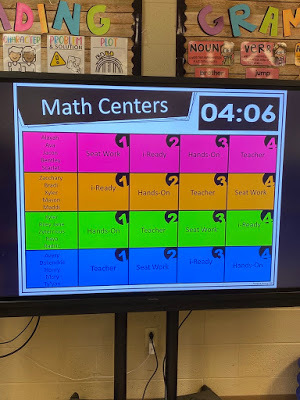
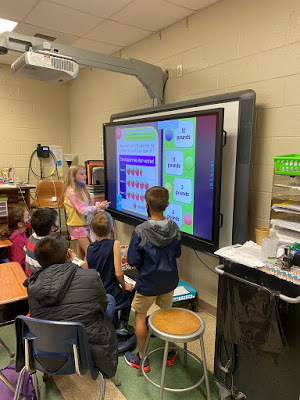
Keep in mind that there are many ways to set up this model. Overall efficacy relies on data being used to continuously group and re-group students, strategic use of adaptive learning tools, independent work that is rigorous and relevant, and the opportunity to collaborate actively. There is only one thing educators can control: the time with students in the classroom. Station rotation, when used strategically, can be used to differentiate while also building essential competencies such as time management and self-regulation. It's a win-win at any level.
July 11, 2021
Pedagogical Leadership
Leadership is leadership. The same essential qualities and characteristics that exemplify what great leaders do have pretty much stayed the same. What has changed are the tools, research, and societal shifts that impact the work. Leadership is both an art and science with the goal of moving the masses towards achieving a common goal. Leading is not easy, and being effective at it is easier said than done. You don’t have to be perfect nor always on your game. You do, however, have to help others achieve a common goal that gets results. There is no more important goal than to improve learning for kids. Hence the need to look at different aspects or styles to improve outcomes.
Pedagogical leadership encompasses all the many ways to support effective teaching and learning. Instructional design is a significant component as teachers need continuous feedback on how to implement the curriculum in innovative ways that result in improved outcomes. While instruction is important, it is only one of many aspects that need attention. Instruction is what the teacher does, whereas learning is what the student does. Here is where a sole emphasis on instructional leadership might not lead to efficacy at scale. Pedagogical leadership focuses on numerous responsibilities and roles that work to ensure a vibrant learning culture that helps to meet the needs of all students.
The main differentiator here is a broader view that includes more attention to what the learner is doing and the supports needed for success. The pedagogical leader works to create collaborative benchmarks that lead to continuous improvement across the system. It requires a deeper understanding of how the brain works and research-based strategies that teachers can readily implement in their classrooms. Observations, both evaluative and non-evaluative, still have immense value. However, the pedagogical leader doesn’t stop here. The use of data is extremely important. Efforts are made to help teachers analyze and use it effectively while the pedagogical leader is doing the same to find ways to close achievement gaps, scale differentiation, and create an equitable culture.
The work doesn’t stop with the above. Investments in time and resources are made to establish ongoing and job-embedded professional learning for staff. One-and-done, drive-by, the flavor of the month, or substanceless sessions are seen, not entertained. Pedagogical leaders are constantly trying to ensure learner success by employing effective strategies to improve family engagement. While working directly with teachers is of utmost importance, empowering parents and guardians to assist in the process is vital.
The pedagogical leader…..
Develops relationships based on trust and mutual respect through mentoring and modelingProvides research and resources to support sound pedagogyMakes time to consistently be in classrooms while providing timely, practical, and specific feedback in collaboration with teachersLearns alongside teachers and administratorsCollects and analyzes evidence to improve implementation of effective strategies
Talking the talk must be accompanied by walking the walk. It’s relatively easy for people to tell others what they should do. However, true pedagogical leaders go through the challenging work of showing how it can be done. Here is some sage advice that I learned long ago as a new principal – “Don’t ask others to do what you are not willing or have not done yourself.” If you want to improve pedagogy - and outcomes – it all starts with you.
July 4, 2021
Your Lasting Legacy
No one goes into the education profession for accolades or to make big bucks, although I wish the latter were a reality. The choice one makes to teach and lead is almost always grounded in the innate desire to make a positive difference in a child's life. On some days, this might seem like an impossible task as a myriad of challenges makes it difficult. While these may vary, the result can lead to questioning the chosen career path. However, when the dust settles, educators can take solace in the fact that the actions they do take to help kids learn do make a difference in both the short and long terms.
Culture, in a classroom or school, is built on a strong relational foundation. Without trust, there are not relationships. Without relationships, no real learning occurs. While achievement often gets the most attention or scrutiny, it's the interactions with kids that set them up for success and often have the most impact well after they have left a classroom. In the final chapter of Disruptive Thinking in Our Classrooms, I highlight the following areas to make this a reality:
Show you careBelieve in ALL kidsWork to unlock potential Impart trustFocus on "what if" instead of "yeah but"
If the goal is to get students to think disruptively, then the right culture has to be in place. Hence, the importance of developing powerful relationships that have the potential to withstand the test of time. Steve Goodier shared a brief story titled "A Teacher's Hand," which speaks to the immense impact educators have when they embrace the tenets above:
Thanksgiving Day was near. The first-grade teacher gave her class a fun assignment—to draw a picture of something for which they were thankful. Most of the class might be considered economically disadvantaged, but still, many would celebrate the holiday with turkey and other traditional goodies of the season. These, the teacher thought, would be the subjects of most of her student's art. And they were.
But Douglas made a different kind of picture. Douglas was a different kind of boy. He was the teacher's true child of misery, frail and unhappy. As other children played at recess, Douglas was likely to stand close by her side. One could only guess at the pain Douglas felt behind those sad eyes. Yes, his picture was different. When asked to draw a picture of something for which he was thankful, he drew a hand. Nothing else. Just an empty hand.
His abstract image captured the imagination of his peers. Whose hand could it be? One child guessed it was the hand of a farmer because farmers raise turkeys. Another suggested a police officer because the police protect and care for people. Still, others guessed it was the hand of God, for God feeds us. And so, the discussion went—until the teacher almost forgot the young artist himself.
When the children had gone on to other assignments, she paused at Douglas' desk, bent down, and asked him whose hand it was. The little boy looked away and murmured, "It's yours, teacher." She recalled the times she had taken his hand and walked with him here or there, as she had the other students. How often had she said, "Take my hand, Douglas, we'll go outside." Or "Let me show you how to hold your pencil." Or "Let's do this together." Douglas was most thankful for his teacher's hand. Brushing aside a tear, she went on with her work.
The story speaks of more than thankfulness. It says something about teachers teaching and parents parenting and friends showing friendship, and how much it means to the Douglas's of the world. They might not always say thanks. But they'll remember the hand that reaches out.
Never underestimate your vital role in impacting the life of a child. Students might not realize it now, but later in life, many will thank you in their own way for your belief in and commitment to them. To fully prepare all learners for their future, we must create classrooms in which disruptive thinking is a major component of the learning pro¬cess. However, disruptive thinking in the classroom will only become a reality when priceless relationships are in place. With these in place, your impact will be felt for generations as the learners you influence today disrupt the bold new world in ways that change it—and us—for the better. This is your lasting legacy.



